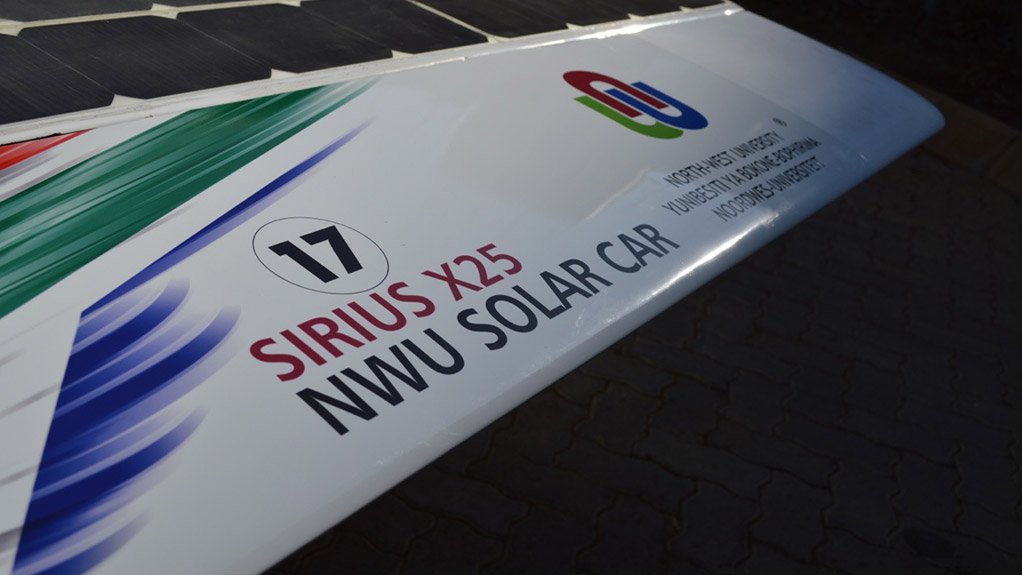NWU to take on international competition at Sasol Solar Challenge
Various improvements, including the exclusive use of German-made Gochermann solar panels, have been made to the North-West University (NWU) solar car team’s Sirius X25, enabling the R1-million sponsored solar car to perform about 20% more effectively.
Nearly a year after becoming the first African team to cross the finish line in the World Solar Challenge in Australia, the NWU team will be defending its title as the best in Africa in the local Sasol Solar Challenge – but this time against even stronger international competition.
With the Sirius X25, which is 4 kg lighter this year and features new electronics and a new control system, the NWU team will once again be competing against 12 other teams in the race from Pretoria to Cape Town, which will take place from September 24 to October 1.
Team leader Professor Albert Helberg notes that six of the teams competing at this year’s Sasol Solar Challenge are international teams, including the first- and the third-place winners of the World Solar Challenge in 2015.
“The NWU solar car team see it as a challenge to become the number one South African team on the podium this year,” he says, adding that the team is focused on competing at the level of world champion teams such as the Nuon Solar Team from the Netherlands’ Delft University of Technology and Tokai University of Japan. He adds that, for the first time in the history of the Sasol Solar Challenge, both will be battling it out simultaneously.
The NWU team comprises 25 engineering students who will be participating in this year’s Challenger Class, the provisions of which are that the entered car must have four wheels, may only use solar energy to complete the entire route, and may only use a maximum surface area of 6 m2 of solar panels.
Helberg notes that the team’s biggest improvement this year is the team’s strategy. “We approached . . . business mathematics and informatics (BMI) [students] to build us a system that determines the car’s optimum speed, given the road profile and the expected solar energy. The purpose is to find a recipe for optimal performance at minimum energy for the race. They succeeded,” he says.
The BMI system broke down the entire route of 2 000 km into 100 m virtual segments, taking into account uphills, downhills, weather variables and altitude to determine exactly which sections of the route must be driven at what speed to minimise the vehicle’s energy consumption as best as possible. This has to be done because the batteries may only be charged by the sun and no other external energy sources may be used.
In their first Sasol Solar Challenge in 2012, the team could travel slightly more than 1 000 km. In 2014, during the same competition, it travelled slightly more than 2 000 km and, in last year’s World Solar Challenge, they could cover a little more than 3 000 km.
“Even though the direct route is only 2 000 km, we are aiming to cover more than 3 200 km by travelling additional routes because the race is against time and distance rather than against other teams. The team covering the longest distance over the eight days, is crowned the winner,” explains Helberg.
The Sirius X25 and its batteries weigh 196 kg. It can reach a top speed of 135 km/h, and is 4.5 m long and 1.8 m wide. It comprises mainly carbon-fibre, with selected aluminium components.
Students will be the drivers, and each one must weigh less than 80 kg. “However, they must not be too light because the driver’s weight is adjusted up to 80 kg by means of weights. Most of our drivers have the perfect weight; the others still have to shed a kilogram or two,” says Helberg.
NWU first participated in the Sasol Solar Challenge in 2012, with only three months’ preparation and a very limited budget. Exceeding all expectations, they took first prize in the Olympia Class. They also improved the South African record for the longest distance covered. In addition, the NWU team received the coveted International FIA (Federation Internationale de l'Automobile) award for renewable energy.
In 2014, they finished the race in fourth place and again improved the South Africa record by covering the longest distance in a single day.
Comments
Press Office
Announcements
What's On
Subscribe to improve your user experience...
Option 1 (equivalent of R125 a month):
Receive a weekly copy of Creamer Media's Engineering News & Mining Weekly magazine
(print copy for those in South Africa and e-magazine for those outside of South Africa)
Receive daily email newsletters
Access to full search results
Access archive of magazine back copies
Access to Projects in Progress
Access to ONE Research Report of your choice in PDF format
Option 2 (equivalent of R375 a month):
All benefits from Option 1
PLUS
Access to Creamer Media's Research Channel Africa for ALL Research Reports, in PDF format, on various industrial and mining sectors
including Electricity; Water; Energy Transition; Hydrogen; Roads, Rail and Ports; Coal; Gold; Platinum; Battery Metals; etc.
Already a subscriber?
Forgotten your password?
Receive weekly copy of Creamer Media's Engineering News & Mining Weekly magazine (print copy for those in South Africa and e-magazine for those outside of South Africa)
➕
Recieve daily email newsletters
➕
Access to full search results
➕
Access archive of magazine back copies
➕
Access to Projects in Progress
➕
Access to ONE Research Report of your choice in PDF format
RESEARCH CHANNEL AFRICA
R4500 (equivalent of R375 a month)
SUBSCRIBEAll benefits from Option 1
➕
Access to Creamer Media's Research Channel Africa for ALL Research Reports on various industrial and mining sectors, in PDF format, including on:
Electricity
➕
Water
➕
Energy Transition
➕
Hydrogen
➕
Roads, Rail and Ports
➕
Coal
➕
Gold
➕
Platinum
➕
Battery Metals
➕
etc.
Receive all benefits from Option 1 or Option 2 delivered to numerous people at your company
➕
Multiple User names and Passwords for simultaneous log-ins
➕
Intranet integration access to all in your organisation





















